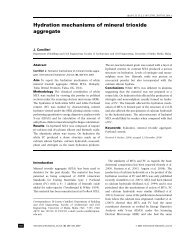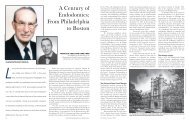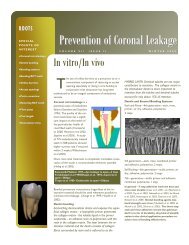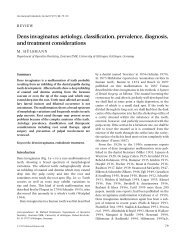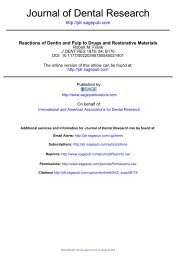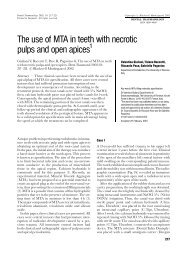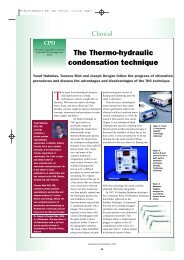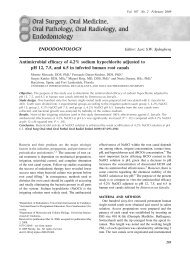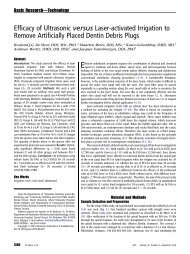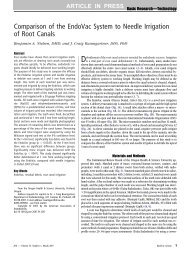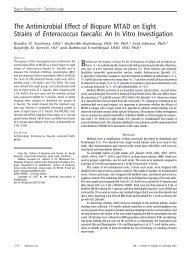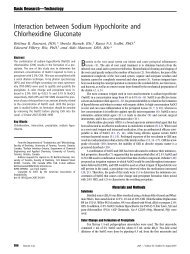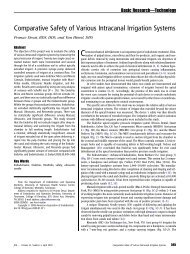Articaine Infiltration for Anesthesia of Mandibular First Molars
Articaine Infiltration for Anesthesia of Mandibular First Molars
Articaine Infiltration for Anesthesia of Mandibular First Molars
You also want an ePaper? Increase the reach of your titles
YUMPU automatically turns print PDFs into web optimized ePapers that Google loves.
CONSORT Clinical Trial<br />
<strong>Articaine</strong> <strong>Infiltration</strong> <strong>for</strong> <strong>Anesthesia</strong> <strong>of</strong> <strong>Mandibular</strong> <strong>First</strong><br />
<strong>Molars</strong><br />
Ian P. Corbett, PhD, Mohammad D. Kanaa, MPhil, John M. Whitworth, PhD, and<br />
John G. Meechan, PhD<br />
Abstract<br />
A<br />
A randomized, controlled trial <strong>of</strong> 31 healthy volunteers rticaine has been used as a local anesthetic in dentistry <strong>for</strong> over 20 years and was<br />
compared 4% articaine with 1:100,000 epinephrine introduced into the United Kingdom in 1999 and the United States in 2000. Artic-<br />
buccal infiltration to buccal plus lingual infiltration <strong>of</strong> aine has been shown in clinical trials to be safe and effective 1–3), and ( our own recent<br />
the same dose <strong>of</strong> drug in achieving pulpal anesthesia <strong>of</strong>work<br />
has shown that a buccal infiltration <strong>of</strong> 4% articaine with 1:100,000 epinephrine is<br />
mandibular first molar teeth. Data were compared with more effective than a similar injection <strong>of</strong> 2% lidocaine with 1:100,000 epinephrine in<br />
efficacy <strong>of</strong> an inferior alveolar nerve block using 2% obtaining pulp anesthesia in mandibular molars <strong>of</strong> healthy volunteers 4). This ( supe-<br />
lidocaine 1:80,000 epinephrine in a cohort <strong>of</strong> 27 <strong>of</strong> theriority<br />
<strong>of</strong> 4% articaine with epinephrine over 2% lidocaine with epinephrine after<br />
volunteers. <strong>Anesthesia</strong> was determined using electronic mandibular infiltration was confirmed by the work <strong>of</strong> Robertson and colleagues 5). (<br />
pulp testing. Buccal and buccal plus lingual infiltrations The success <strong>of</strong> mandibular infiltration with articaine and epinephrine <strong>for</strong> first molar<br />
<strong>of</strong> articaine with epinephrine did not differ in efficacy inanesthesia<br />
is comparable to that <strong>of</strong> an inferior alveolar nerve block with 2% lidocaine<br />
obtaining pulpal anesthesia <strong>for</strong> mandibular permanent and epinephrine when similar outcome measures are used 6 –12). ( A recent blinded<br />
first molars (p 0.17). Efficacy <strong>of</strong> 4% articaine with crossover study by Jung 13) ( directly compared the two techniques, with statistically<br />
epinephrine infiltrations <strong>for</strong> first molar pulp anesthesia comparable success <strong>of</strong> around 50% <strong>for</strong> articaine infiltration and lidocaine inferior<br />
was similar to that <strong>of</strong> an IANB using lidocaine withalveolar<br />
nerve blocks <strong>for</strong> mandibular first molar anesthesia.<br />
epinephrine over a 30-minute study period (96 and 80 Anesthetic failure after an inferior alveolar nerve block may be caused by several<br />
episodes <strong>of</strong> no response to maximal stimulation respec- factors, including collateral innervation 14 ( –16) and supplementary injections can be<br />
tively, p 0.097). Subjective tooth numbness was useful in overcoming such failure 17). ( Supplemental intraosseous administration <strong>of</strong><br />
more common after IANB than buccal infiltration (p<br />
lidocaine or articaine has been reported to be effective in approximately 90% <strong>of</strong> clini-<br />
0.005). The discom<strong>for</strong>t <strong>of</strong> buccal infiltration with articcally inadequate anesthesia 18 ( –20). Rosenberg and colleagues 21) ( showed articaine<br />
aine was volume dependent (p 0.017) and similar to and lidocaine to have a similar efficacy <strong>for</strong> pain reduction when given as a supplemental<br />
that <strong>of</strong> an IANB. (J Endod 2008;34:514 –518) buccal infiltration <strong>for</strong> inadequate pulpal anesthesia during endodontic procedures.<br />
Additionally, the combination <strong>of</strong> a buccal and lingual infiltration <strong>of</strong> lidocaine has been<br />
Key Words<br />
shown to be more effective than buccal alone in obtaining pulpal anesthesia <strong>of</strong> lower<br />
<strong>Anesthesia</strong>, articaine, inferior alveolar, infiltration, lido- anterior teeth (22).<br />
caine, mandibular<br />
The purpose <strong>of</strong> the present investigation was to compare the efficacy <strong>of</strong> articaine<br />
buccal infiltration to buccal plus lingual infiltration <strong>of</strong> the same dose in the lower first<br />
molar region as a means <strong>of</strong> providing pulpal anesthesia <strong>of</strong> the mandibular first molar<br />
tooth in healthy volunteers. In addition, the results <strong>of</strong> the present study were compared<br />
From the School <strong>of</strong> Dental Sciences, Newcastle University, to those obtained in a cohort <strong>of</strong> the present subjects who received 2% lidocaine with<br />
Newcastle upon Tyne, United Kingdom.<br />
Address requests <strong>for</strong> reprints to Dr I.P. Corbett, School <strong>of</strong> 1:80,000 epinephrine as an inferior dental block in a concurrent investigation 23). (<br />
Dental Sciences, Newcastle University, Framlington Place,<br />
Newcastle upon Tyne, United Kingdom NE2 4BW. E-mail address:<br />
i.p.corbett@ncl.ac.uk.<br />
0099-2399/$0 - see front matter<br />
Copyright © 2008 by the American Association <strong>of</strong><br />
Endodontists.<br />
doi:10.1016/j.joen.2008.02.042<br />
Materials and Methods<br />
A power calculation using data from a previous study 22) ( indicated that 31<br />
subjects would provide a 90% chance <strong>of</strong> detecting an effect size <strong>of</strong> 0.83 (a change <strong>of</strong><br />
0.83 standard deviations [SDs]) in a continuous outcome measure, assuming a significance<br />
level <strong>of</strong> 5% and a correlation <strong>of</strong> 0.5 between responses from the same subject.<br />
The null hypothesis tested was that buccal and buccal plus lingual infiltrations <strong>of</strong> articaine<br />
did not differ in their efficacy <strong>for</strong> pulpal anesthesia <strong>of</strong> mandibular first permanent<br />
molar teeth.<br />
Volunteers required the presence <strong>of</strong> at least one vital lower first molar tooth.<br />
Exclusion criteria included any reported allergy to local anesthetic agents, unstable<br />
cardiovascular disease, pregnancy, and neurologic disorders with sensory disturbance.<br />
Approval was obtained from the institutional review board, the Local Research Ethics<br />
Committee, and the UK Medicines and Healthcare Products Regulatory Authority. All<br />
participants provided in<strong>for</strong>med written consent.<br />
Although three parties were involved at each stage, the investigation was regarded<br />
as a double-blind, randomized controlled trial as both the subject and individual assessing<br />
outcome were blinded to the anesthetic administration method. The investigator<br />
514 Corbett et al. JOE — Volume 34, Number 5, May 2008
administering all anesthetics had no involvement in measuring outcomes.<br />
Randomization was per<strong>for</strong>med by a researcher who was not<br />
involved in delivering the local anesthetic or assessing outcome<br />
(JGM) using a Web-based computer program (http://department.obg.<br />
cuhk.edu.hk/researchsupport/random_integer.asp). Blinding <strong>of</strong> allocation<br />
was maintained until completion <strong>of</strong> the trial. All interventions<br />
were per<strong>for</strong>med in a dental hospital clinical setting.<br />
The following treatments were given at separate visits:<br />
1. Buccal infiltration <strong>of</strong> 1.8 mL 4% articaine with 1:100,000 epinephrine<br />
in the mucobuccal fold adjacent to a mandibular first<br />
molar with simulated injection (ie, needle penetration only) lingually.<br />
2. Buccal infiltration <strong>of</strong> 0.9 mL 4% articaine with 1:100,000 epinephrine<br />
plus lingual infiltration <strong>of</strong> 0.9 mL 4% articaine with<br />
1:100,000 epinephrine.<br />
Every volunteer received each treatment over 2 visits separated by<br />
at least 1 week. The same mandibular molar area was anesthetized at<br />
each visit; all injections were per<strong>for</strong>med by a single operator (IPC). A<br />
dental aspirating syringe fitted with a 0.40 35 mm needle (Ultra Safety<br />
Plus XL; Deproco, Maidstone, UK) was used to deposit 4% articaine with<br />
1:100,000 epinephrine (Septanest 1:100,000; Deproco, Maidstone,<br />
UK) at a rate <strong>of</strong> 0.9 mL per 15 seconds. Buccal injections were administered<br />
first at each visit, with a total needle penetration time <strong>of</strong> 30<br />
seconds (1.8 mL over 30 seconds or 15 seconds penetration with no<br />
administration followed by 0.9 mL over 15 seconds). On the lingual<br />
side, the 0.9 mL <strong>of</strong> solution was injected over 15 seconds, and the<br />
simulated lingual injection was a 15-second needle penetration only to<br />
blind the subject to the method <strong>of</strong> infiltration. In the IANB investigation<br />
(reported previously, 23), 2 mL <strong>of</strong> 2% lidocaine with 1:80,000 epinephrine<br />
(Lignospan Special; Dentsply, Weybridge, UK) was administered<br />
over 1 minute using the direct or Halstead approach by the same operator<br />
who administered the infiltrations described earlier.<br />
The investigator <strong>of</strong> anesthetic efficacy (MDK) was blinded to the<br />
infiltration method used at each visit. Pulpal anesthesia was determined<br />
by using an electronic pulp tester (Analytic Technology, Redmond, WA).<br />
The pulp tester was set to deliver a0to80digital reading on a rate<br />
setting <strong>of</strong> five, corresponding to a nonlinear increasing voltage, zero to<br />
maximum, over 30 seconds. Calibration <strong>of</strong> the pulp tester showed a<br />
maximum voltage <strong>of</strong> 270 V at an output impedance <strong>of</strong> 140 K ohms. The<br />
appropriate mandibular first molar was tested twice be<strong>for</strong>e injection,<br />
and the mean <strong>of</strong> these two readings was considered as baseline. Pulp<br />
testing was then repeated once every 2 minutes after injection <strong>for</strong> 30<br />
minutes giving a total <strong>of</strong> 15 time points. In order to test the reliability <strong>of</strong><br />
the pulp tester, a nonanesthetized canine tooth on the contralateral side<br />
<strong>of</strong> the mandible was tested at each time point. The canine tooth was<br />
chosen as a control because <strong>of</strong> the ease <strong>of</strong> access and moisture control<br />
in addition to the possibility <strong>of</strong> the contralateral molar being compromised<br />
by disease. The number <strong>of</strong> occasions (out <strong>of</strong> the 15 time points)<br />
on which there was no response to maximum stimulation was determined<br />
and the responses <strong>for</strong> the two treatments were compared across<br />
the 31 subjects.<br />
For the concurrent IANB investigation, pulp testing was per<strong>for</strong>med<br />
under identical conditions by the same investigator (MDK), with a variation<br />
only in the time interval used (23). Testing was carried out every<br />
2 minutes <strong>for</strong> 10 minutes and then at 5-minute intervals to 45 minutes,<br />
giving seven corresponding time points between 0 and 30 minutes in the<br />
two studies.<br />
The criterion <strong>for</strong> successful anesthesia after infiltration was no<br />
response to the maximum stimulation, a reading <strong>of</strong> 80, on two or more<br />
consecutive measurements (4). The onset <strong>of</strong> first molar pulp anesthesia<br />
was taken as the time from the beginning <strong>of</strong> at least two consecutive<br />
CONSORT Clinical Trial<br />
maximum readings without sensation. The duration <strong>of</strong> anesthesia was<br />
similarly taken as the time from the beginning <strong>of</strong> at least two consecutive<br />
maximum readings without sensation until the onset <strong>of</strong> more than two<br />
responses at less than maximum stimulation or the end <strong>of</strong> the 30 minutes<br />
<strong>of</strong> the trial, whichever was sooner. In addition to objective assessment<br />
<strong>of</strong> pulpal anesthesia, volunteers were asked to report to the investigator<br />
when sensation in the molar teeth, lower lip, and floor <strong>of</strong> mouth/<br />
tongue felt different or “numb.” Time <strong>of</strong> reported onset and presence <strong>of</strong><br />
tooth, labial, and lingual s<strong>of</strong>t-tissue anesthesia at each pulp testing time<br />
point were recorded.<br />
Injection discom<strong>for</strong>t <strong>for</strong> each infiltration, dummy lingual infiltration,<br />
and the IANB was self-recorded by subjects on 100-mm visual<br />
analogue scales (VAS) with endpoints “no pain” (0 mm) and “unbearable<br />
pain” (100 mm).<br />
Data were analyzed by Pearson Chi-square, Fisher’s exact test,<br />
McNemar test and Student’s t tests, per<strong>for</strong>med using a statistical analysis<br />
package (SPSS 14.0, SPSS limited, Chicago, USA).<br />
Results<br />
Buccal versus Buccal Plus Lingual <strong>Infiltration</strong><br />
The study was per<strong>for</strong>med over a 6-month period. Thirty-one<br />
healthy volunteers, recruited predominantly from the local university<br />
(including dental students) population, participated in the study, with<br />
no exclusions; 16 women (52%) and 15 men (48%), with a mean age<br />
<strong>of</strong> 23 years (range, 20-30 years) were included. Eighteen subjects received<br />
buccal and lingual infiltration with articaine at the first visit, 13<br />
receiving buccal and simulated injections initially. The mean time between<br />
interventions was 41 days (range, 7-105). All recruited participants<br />
received the intended treatment and completed the trial; no protocol<br />
deviation was noted, and no adverse events were reported.<br />
The number <strong>of</strong> episodes <strong>of</strong> no sensation on maximal stimulation<br />
(80) in first molars at each time point after injection was not significantly<br />
different (p 0.58) after combined buccal and lingual infiltrations<br />
compared with buccal infiltration alone, with 242 episodes and<br />
236 episodes, respectively (Fig. 1). Twenty (64.5%) volunteers experienced<br />
anesthetic success (two or more consecutive episodes <strong>of</strong> maximal<br />
stimulation without sensation) after articaine buccal infiltration<br />
compared with 21 (67.7%) after the combined buccal and lingual infiltration.<br />
This difference was not significant (p 1.0).<br />
The mean onset <strong>of</strong> first molar pulpal anesthesia was 6.5 minutes<br />
(SD, 5.5 minutes) after buccal and 7.5 minutes (SD, 6.0 minutes) after<br />
buccal plus lingual infiltrations. The difference was not significant (t <br />
0.57, p 0.57).<br />
The maximum duration <strong>of</strong> anesthesia possible in this trial was 28<br />
minutes. Six subjects achieved 28 minutes <strong>of</strong> continuous anesthesia<br />
after buccal infiltration and four subjects after buccal plus lingual infiltration.<br />
The mean duration <strong>of</strong> successful pulpal anesthesia was 21.6<br />
minutes (SD, 7.9 minutes) after buccal and 20.5 minutes (SD, 7.8<br />
minutes) after buccal plus lingual infiltrations. The difference was not<br />
significant (t 0.46, p 0.65).<br />
All volunteers reported lip numbness after buccal and buccal plus<br />
lingual infiltrations, with a mean onset <strong>of</strong> 51.2 seconds (SD, 26.6 seconds)<br />
and 61.0s (SD 51.1 seconds), respectively. The difference was<br />
not significant (t 1.1, p 0.30). Lingual mucosa numbness was<br />
reported by 7 (22.6%) subjects after buccal and 21 (67.7%) after<br />
combined buccal and lingual infiltration. This difference was significant<br />
(p 0.001). Twenty-four (77.4%) volunteers reported subjective<br />
tooth numbness after buccal infiltration alone and 27 (87.1%) after<br />
buccal and lingual infiltration. The difference was not significant (p <br />
0.38).<br />
JOE — Volume 34, Number 5, May 2008 <strong>Articaine</strong> <strong>Infiltration</strong> <strong>for</strong> <strong>Anesthesia</strong> <strong>of</strong> <strong>Mandibular</strong> <strong>First</strong> <strong>Molars</strong> 515
CONSORT Clinical Trial<br />
Figure 1. The percentage <strong>of</strong> volunteers reporting no sensation on maximal stimulation (80) in first mandibular molars after articaine buccal (B) versus articaine<br />
buccal and lingual (B&L) infiltration.<br />
Lingual penetration and lingual injection showed similar discom<strong>for</strong>t<br />
over the two visits, with mean VAS scores <strong>of</strong> 19.7 mm (range, 0-51)<br />
and 21.5 mm (range, 1-78), respectively (t 0.68, p 0.50). <strong>Articaine</strong><br />
buccal infiltration with a volume <strong>of</strong> 1.8 mL (mean, 20.9 mm; range,<br />
0-73) was significantly more uncom<strong>for</strong>table than 0.9 mL <strong>of</strong> infiltration<br />
(mean, 15.2 mm; range, 0-54; t 2.5; p 0.017).<br />
<strong>Articaine</strong> Buccal <strong>Infiltration</strong> versus Lidocaine IANB<br />
Twenty-seven <strong>of</strong> the volunteers enrolled in this current investigation<br />
were also participating in a concurrent study investigating the efficacy<br />
<strong>of</strong> inferior alveolar nerve blocks with 2% lidocaine 1:100,000<br />
epinephrine (23). The study was per<strong>for</strong>med under identical randomized,<br />
double-blinded, controlled conditions by the same investigators.<br />
Data used in this comparison related to delivery <strong>of</strong> an IANB at the rate <strong>of</strong><br />
2.0 mL over 1 minute. Seven <strong>of</strong> the time points up to 30 minutes postinjection<br />
corresponded between the present and the IANB investigations.<br />
The cohort involved in both trials consisted <strong>of</strong> 12 men (44.4%) and 15<br />
women (55.6%), with a mean age <strong>of</strong> 22.8 years (range, 20-30 years). Of<br />
these 27 volunteers, 17 received the IANB be<strong>for</strong>e buccal infiltrations.<br />
Comparing the present buccal infiltration data with the IANB data,<br />
<strong>of</strong> the 27 volunteers, 19 (70.4%) experienced anesthetic success after<br />
articaine buccal infiltration compared with 15 (55.6%) after the IANB<br />
(p 0.39), with a mean onset <strong>of</strong> pulpal anesthesia <strong>of</strong> 6.8 minutes (SD,<br />
6.2 minutes) and 5.9 minutes (SD, 4.4 minutes) respectively (independent<br />
samples test: t 0.54, p 0.60). The number <strong>of</strong> episodes <strong>of</strong> no<br />
sensation on maximal (80 A) stimulation in first molars at each time<br />
point after injection (Fig. 2) was greater after the articaine buccal infiltration<br />
(96 episodes) compared with IANB (80 episodes); this was not<br />
statistically significant (p 0.097).<br />
Subjective lip numbness was reported in all but one intervention<br />
(an IANB). The onset <strong>of</strong> lip numbness in the remaining volunteers<br />
ranged between 20 and 115 seconds (mean, 49.9 seconds; SD, 21.1<br />
seconds) after articaine buccal infiltration alone and between 6 and 730<br />
seconds after IANB injection (mean, 97.2 seconds; SD, 165.9 seconds).<br />
This difference was not significant (t 1.5, p 0.14). All volunteers<br />
reported tongue numbness after IANB injection, but only six (22.2%)<br />
reported lingual mucosa numbness after articaine buccal infiltration.<br />
This difference was significant (p 0.001). Subjective tooth numbness<br />
was significantly more common after IANB compared to articaine buccal<br />
infiltration (27 vs 20 cases, respectively; p 0.005).<br />
No significant difference was noted in injection discom<strong>for</strong>t between<br />
articaine buccal infiltration (mean VAS 22.4 mm, SD 18.4 mm)<br />
and lidocaine IANB (20.7 mm, SD 17.4 mm) in the 27 subjects (t <br />
0.41, p 0.69).<br />
Discussion<br />
The use <strong>of</strong> electrical stimulation is considered a safe and precise<br />
method to evaluate pulpal anesthesia in vital asymptomatic teeth (24,<br />
25). The absence <strong>of</strong> perception to the maximum output <strong>of</strong> the pulp<br />
Figure 2. The percentage <strong>of</strong> volunteers reporting no sensation on maximal stimulation (80) in first mandibular molars after articaine buccal infiltration (B) versus<br />
lidocaine IANB injection.<br />
516 Corbett et al. JOE — Volume 34, Number 5, May 2008
tester (80 reading) has been widely used as a criterion <strong>for</strong> pulpal anesthesia<br />
(4, 10, 26, 27).<br />
The results <strong>of</strong> the present study show infiltration anesthesia efficacy<br />
in the mandibular molar region with 4% articaine and epinephrine<br />
(1;100,000) in adults <strong>of</strong> approximately 65%. This result is similar to<br />
that reported by Haas et al (28) but lower than that noted by Robertson<br />
et al (5). Buccal infiltration with articaine has been shown to achieve a<br />
higher success rate in mandibular molar anesthesia than that reported<br />
with a buccal infiltration <strong>of</strong> 2% lidocaine with epinephrine (1:100,000)<br />
(4, 5). This increase in efficacy may be the result <strong>of</strong> a concentration<br />
effect (1) or greater diffusion <strong>of</strong> articaine (29, 30).<br />
The results <strong>of</strong> this investigation show that no advantage in anesthetic<br />
success was obtained from dividing the administration <strong>of</strong> a dose <strong>of</strong><br />
articaine between buccal and lingual infiltrations in the molar region <strong>of</strong><br />
the mandible compared with buccal infiltration alone. This is in contrast<br />
to the mandibular incisor region in which the combination <strong>of</strong> buccal<br />
plus lingual infiltration has been shown to be more effective than the<br />
same dose given buccally (22). This difference may be the result <strong>of</strong> the<br />
involvement <strong>of</strong> accessory nerves on the lingual side <strong>of</strong> the mandible (eg,<br />
in the innervation <strong>of</strong> the anterior but not the posterior teeth) (31). The<br />
effect is unlikely to relate to bone thickness/density and access to IAN;<br />
although the cortical plate may be around 0.5 mm thicker on the lingual<br />
than the buccal aspect (32), the inferior alveolar canal is predominantly<br />
toward the lingual cortex (33).<br />
To eliminate a dose effect, the overall volume injected either on the<br />
buccal or in the combined buccal and lingual administration was kept<br />
constant. The minimum buccal articaine dose required to produce successful<br />
pulpal anesthesia has not been investigated in this trial. The role<br />
<strong>of</strong> lingual infiltration may become relevant if the buccal dose is reduced<br />
below a “critical” threshold.<br />
Previous studies have reported the peak anesthetic effect <strong>of</strong> infiltration<br />
anesthesia in the anterior mandible in the region <strong>of</strong> 8 to 10<br />
minutes (22, 34). In the current study, the anesthetic effect <strong>for</strong> the<br />
mandibular first molar peaked 16 to 20 minutes after infiltrations, the<br />
lag possibly resulting from a greater physical diffusion barrier. In comparison,<br />
the peak <strong>for</strong> the IANB occurred earlier (10 minutes) but was<br />
lower (Fig. 2), although neither <strong>of</strong> these differences was significant.<br />
In the present study, approximately 70% <strong>of</strong> the volunteers who<br />
achieved successful first molar pulpal anesthesia after articaine buccal<br />
plus lingual infiltrations did so within 10 minutes. The corresponding<br />
figures <strong>for</strong> buccal infiltration alone and IANB were 85% and 93%, respectively.<br />
No significant difference was noted between the techniques<br />
with regard to overall mean onset; these were 7.5 minutes <strong>for</strong> articaine<br />
buccal plus lingual infiltration, 6.5 minutes <strong>for</strong> articaine buccal infiltration<br />
only, and 5.9 minutes <strong>for</strong> IANB with lidocaine. These results suggest<br />
that a period <strong>of</strong> 6 to 10 minutes should elapse be<strong>for</strong>e testing <strong>for</strong> pulpal<br />
anesthesia or indeed be<strong>for</strong>e commencing a potentially painful procedure<br />
such as accessing the dental pulp.<br />
Reporting <strong>of</strong> subjective lip numbness was similar after both infiltration<br />
techniques and IANB. An earlier mean onset time <strong>for</strong> lip numbness<br />
was reported with the larger dose <strong>of</strong> articaine buccal infiltration<br />
(1.8 mL); however, this was not statistically significant. Not surprisingly,<br />
the reporting <strong>of</strong> subjective numbness <strong>of</strong> the lingual mucosa in the infiltration<br />
study was more common after a lingual injection (67%), with<br />
seven subjects reporting lingual mucosa numbness after buccal infiltration<br />
alone. All volunteers reported subjective lingual numbness after<br />
IANB. Approximately 77% <strong>of</strong> subjects reported first molar tooth numbness<br />
after articaine buccal infiltration compared with 87% after articaine<br />
buccal plus lingual infiltrations with no significant differences between<br />
the two techniques. Subjective tooth numbness was significantly<br />
more common after IANB than articaine buccal infiltration. Reporting <strong>of</strong><br />
lingual anesthesia after lingual infiltration may have been expected to be<br />
CONSORT Clinical Trial<br />
more common than recorded in the present study. This may reflect the<br />
subjectivity <strong>of</strong> self-reporting and may have been different if objective<br />
measurement was undertaken. It is possible that tooth numbness is<br />
more readily perceived (subjects being seen to tap their teeth together<br />
to assess this). In addition, anesthesia <strong>of</strong> the teeth may “confuse” assessment<br />
<strong>of</strong> lingual anesthesia, as seen by the higher incidence <strong>of</strong> reported<br />
subjective tooth numbness after buccal plus lingual infiltration.<br />
This may warrant further investigation.<br />
In the present study, lingual injection and lingual needle penetration<br />
produced similar discom<strong>for</strong>t over the two visits. This is in contrast<br />
to the results <strong>of</strong> Meechan et al (31) who reported lingual injection was<br />
more uncom<strong>for</strong>table than needle penetration with 2% lidocaine local<br />
anesthetic in the same region. This may be because buccal infiltration<br />
was always administered first and may diffuse deeply into the bone (29,<br />
30), resulting in the lingual s<strong>of</strong>t-tissue anesthesia as described earlier.<br />
Similarly, one study showed that extraction <strong>of</strong> teeth in the maxilla was<br />
possible with articaine buccal infiltration only (35), additional evidence<br />
<strong>of</strong> transalveolar diffusion. Other studies however have failed to show<br />
such diffusion (28).<br />
The present results show that the discom<strong>for</strong>t <strong>of</strong> infiltrating 4%<br />
articaine with 1:100,000 epinephrine in the mandibular buccal sulcus<br />
increases with the volume <strong>of</strong> anesthetic solution. This is in contrast to<br />
data reported after lidocaine infiltration (31) and may suggest a concentration<br />
effect as opposed to a simple volume consequence. Because<br />
low-volume lingual infiltration discom<strong>for</strong>t is akin to large volume buccal<br />
infiltration, division <strong>of</strong> the dose between the two sites af<strong>for</strong>ds no<br />
benefit to the patient in terms <strong>of</strong> discom<strong>for</strong>t. Nevertheless, the mean<br />
scores reported by the volunteers <strong>for</strong> all routes <strong>of</strong> administration <strong>of</strong><br />
local anesthetic in the first molar region represent mild discom<strong>for</strong>t only<br />
(36).<br />
The results presented here provide evidence to support the view<br />
that a mandibular infiltration with 4% articaine with epinephrine can be<br />
as effective as an inferior alveolar nerve block over the 30-minute study<br />
period (13). The success rates reported in the present and other trials<br />
<strong>of</strong> inferior alveolar nerve block efficacy (6–13) may appear low compared<br />
with those that would be apparent in clinical practice; however,<br />
the criteria <strong>for</strong> success using an electronic pulp tester in such trials is<br />
more stringent than subjective ratings (10). Such pr<strong>of</strong>ound anesthesia<br />
may not be necessary to per<strong>for</strong>m many less invasive clinical procedures<br />
(11), and when pr<strong>of</strong>ound pulpal anesthesia is required, clinical testing<br />
with an electronic pulp tester would be indicated.<br />
Although buccal infiltration with articaine is not without disadvantages,<br />
avoidance <strong>of</strong> inferior alveolar nerve blocks <strong>for</strong> restorative dentistry<br />
has a number <strong>of</strong> advantages. <strong>Infiltration</strong> produces less unwanted<br />
s<strong>of</strong>t-tissue anesthesia <strong>for</strong> minimally invasive procedures, a supplementary<br />
injection being required <strong>for</strong> lingual anesthesia. Similarly, a shorter<br />
duration <strong>of</strong> action (4, 5, 7, 8) may or may not be an advantage <strong>of</strong><br />
articaine buccal infiltration over lidocaine inferior alveolar nerve block<br />
depending on the procedure undertaken and a repeat infiltration may<br />
be required. Trismus and nonsurgical paresthesia as a result <strong>of</strong> damage<br />
from the needle to the inferior alveolar or lingual nerves is avoided<br />
(37). In addition, infiltration techniques may be preferred in certain<br />
patient groups such as those suffering from hemophilia in order to<br />
reduce the chances <strong>of</strong> dangerous hemorrhage. <strong>Infiltration</strong> is a simpler<br />
technique than other alternatives to mandibular blocks such as intraosseous<br />
and intraligamentary injections. <strong>Infiltration</strong> anesthesia does<br />
not require the specialized equipment needed <strong>for</strong> intraosseous delivery,<br />
is less destructive to the periodontium, and avoids the large bacteremia<br />
that follows intraligamentary injections (38, 39). <strong>Articaine</strong> benefits<br />
from a shorter plasma half-life compared with other amide local anesthetics<br />
(29, 30) and when given as an infiltration should circumvent the<br />
JOE — Volume 34, Number 5, May 2008 <strong>Articaine</strong> <strong>Infiltration</strong> <strong>for</strong> <strong>Anesthesia</strong> <strong>of</strong> <strong>Mandibular</strong> <strong>First</strong> <strong>Molars</strong> 517
CONSORT Clinical Trial<br />
possible concentration-related neurotoxicity associated with regional<br />
block methods when 4% solutions are used (40, 41).<br />
Conclusions<br />
Buccal and buccal plus lingual infiltrations <strong>of</strong> articaine with epinephrine<br />
did not differ in their efficacy in obtaining pulpal anesthesia<br />
<strong>for</strong> mandibular permanent first molars. Anesthetic efficacy <strong>of</strong> 4% articaine<br />
with epinephrine infiltrations <strong>for</strong> first molar pulp anesthesia was<br />
similar to that <strong>of</strong> an IANB using 2% lidocaine with epinephrine over 30<br />
minutes. The discom<strong>for</strong>t <strong>of</strong> buccal infiltration with articaine was dependent<br />
on the volume injected and similar to that <strong>of</strong> an IANB.<br />
References<br />
1. Malamed SF, Gagnon S, Leblanc D. Efficacy <strong>of</strong> articaine: a new amide local anesthetic.<br />
J Am Dent Assoc 2000;131:635–42.<br />
2. Malamed SF, Gagnon S, Leblanc D. <strong>Articaine</strong> hydrochloride: a study <strong>of</strong> the safety <strong>of</strong> a<br />
new amide local anesthetic. J Am Dent Assoc 2001;132:177–85.<br />
3. Hersh EV, Giannakopoulos H, Levin LM, et al. The pharmacokinetics and cardiovascular<br />
effects <strong>of</strong> high-dose articaine with 1:100,000 and 1:200,000 epinephrine. J Am<br />
Dent Assoc 2006;137:1562–71.<br />
4. Kanaa MD, Whitworth JM, Corbett IP, Meechan JG. <strong>Articaine</strong> and lidocaine mandibular<br />
buccal infiltration anesthesia: a prospective randomized double-blind crossover<br />
study. J Endod 2006;32:296–8.<br />
5. Robertson D, Nusstein J, Reader A, Beck M, McCartney M. The anesthetic efficacy <strong>of</strong><br />
articaine in buccal infiltration <strong>of</strong> mandibular posterior teeth. J Am Dent Assoc<br />
2007;138:1104–12.<br />
6. Childers M, Reader A, Nist R, Beck M, Meyers WJ. Anesthetic efficacy <strong>of</strong> the periodontal<br />
ligament injection after an inferior alveolar nerve block. J Endod<br />
1996;22:317–20.<br />
7. Dagher FB, Yared GM, Machtou P. An evaluation <strong>of</strong> 2% lidocaine with different<br />
concentrations <strong>of</strong> epinephrine <strong>for</strong> inferior alveolar nerve block. J Endod<br />
1997;23:78–80.<br />
8. Goodman A, Reader A, Nusstein J, Beck M, Weaver J. Anesthetic efficacy <strong>of</strong> lidocaine/<br />
meperidine <strong>for</strong> inferior alveolar nerve blocks. Anesth Prog 2006;53:131–39.<br />
9. Mikesell P, Nusstein J, Reader A, Beck M, Weaver J. A comparison <strong>of</strong> articaine and<br />
lidocaine <strong>for</strong> inferior alveolar nerve blocks. J Endod 2005;31:265–70.<br />
10. McLean C, Reader A, Beck M, Meyers WJ. An evaluation <strong>of</strong> 4% prilocaine and 3%<br />
mepivacaine compared with 2% lidocaine (1:100,000 epinephrine) <strong>for</strong> inferior<br />
alveolar nerve block. J Endod 1993;19:146–50.<br />
11. Moore PA, Boynes SG, Hersh EV, et al. The anesthetic efficacy <strong>of</strong> 4 percent articaine<br />
1:200,000 epinephrine: two controlled clinical trials. J Am Dent Assoc<br />
2006;137:1572–81.<br />
12. Nist RA, Reader A, Beck M, Meyers WJ. An evaluation <strong>of</strong> the incisive nerve block and<br />
combination inferior alveolar and incisive nerve blocks in mandibular anesthesia. J<br />
Endod 1992;18:455–9.<br />
13. Jung IY, Kim JH, Kim ES, Lee CY, Lee SJ. An evaluation <strong>of</strong> buccal infiltrations and<br />
inferior alveolar blocks in pulpal anesthesia <strong>for</strong> mandibular first molars. J Endod<br />
2008;34:11–13.<br />
14. Pogrel MA, Smith R, Ahani R. Innervation <strong>of</strong> the mandibular incisors by the mental<br />
nerve. J Oral Maxill<strong>of</strong>ac Surg 1997;55:961–3.<br />
15. Meechan JG. Why does local anaesthesia not work every time? Dent Update 2005;32:<br />
66–8., 70–2.<br />
16. Yonchak T, Reader A, Beck M, Meyers WJ. Anesthetic efficacy <strong>of</strong> unilateral and<br />
bilateral inferior alveolar nerve blocks to determine cross innervation in anterior<br />
teeth. Oral Surg Oral Med Oral Pathol Oral Radiol Endod 2001;92:132–5.<br />
17. Meechan JG. Supplementary routes to local anaesthesia. Int Endod J<br />
2002;35:885–96.<br />
18. Bigby J, Reader A, Nusstein J, Beck M, Weaver J. <strong>Articaine</strong> <strong>for</strong> supplemental intraosseous<br />
anesthesia in patients with irreversible pulpitis. J Endod 2006;32:1044–47.<br />
19. Nusstein J, Reader A, Nist R, Beck M, Meyers WJ. Anesthetic efficacy <strong>of</strong> the supplemental<br />
intraosseous injection <strong>of</strong> 2% lidocaine with 1:100,000 epinephrine in irreversible<br />
pulpitis. J Endod 1998;24:487–91.<br />
20. Parente SA, Anderson RW, Herman WW, Kimbrough WF, Weller RN. Anesthestic<br />
efficacy <strong>of</strong> the supplemental intraosseous injection <strong>for</strong> teeth with irreversible pulpitis.<br />
J Endod 1998;24:826–8.<br />
21. Rosenberg PA, Amin KG, Zibari Y, Lin LM. Comparison <strong>of</strong> 4% articaine with 1:100,000<br />
epinephrine and 2% lidocaine with 1:100,000 epinephrine when used as a supplemental<br />
anesthetic. J Endod 2007;33:403–5.<br />
22. Meechan JG, Ledvinka JI. Pulpal anaesthesia <strong>for</strong> mandibular central incisor teeth: a<br />
comparison <strong>of</strong> infiltration and intraligamentary injections. Int Endod J<br />
2002;35:629–34.<br />
23. Kanaa MD, Meechan JG, Corbett IP, Whitworth JM. Speed <strong>of</strong> injection influences<br />
efficacy <strong>of</strong> inferior alveolar nerve blocks: a double-blind randomized controlled trial<br />
in volunteers. J Endod 2006;32:919–23.<br />
24. Dreven LJ, Reader A, Beck M, Meyers WJ, Weaver J. An evaluation <strong>of</strong> an electric pulp<br />
tester as a measure <strong>of</strong> analgesia in human vital teeth. J Endod 1987;13:233–8.<br />
25. Certosimo AJ, Archer RD. A clinical evaluation <strong>of</strong> the electric pulp tester as an<br />
indicator <strong>of</strong> local anesthesia. Oper Dent 1996;21:25–30.<br />
26. Vreeland DL, Reader A, Beck M, Meyers W, Weaver J. An evaluation <strong>of</strong> volumes and<br />
concentrations <strong>of</strong> lidocaine in human inferior alveolar nerve block. J Endod<br />
1989;15:6–12.<br />
27. Hinkley SA, Reader A, Beck M, Meyers WJ. An evaluation <strong>of</strong> 4% prilocaine with<br />
1:200,000 epinephrine and 2% mepivacaine with 1:20,000 levonordefrin compared<br />
with 2% lidocaine with 1: 100,000 epinephrine <strong>for</strong> inferior alveolar nerve block.<br />
Anesth Prog 1991;38:84–9.<br />
28. Haas DA, Harper DG, Saso MA, Young ER. Comparison <strong>of</strong> articaine and prilocaine<br />
anesthesia by infiltration in maxillary and mandibular arches. Anesth Prog<br />
1990;37:230–7.<br />
29. Oertel R, Rahn R, Kirch, W. Clinical pharmacokinetics <strong>of</strong> articaine. Clin Pharmacokinet<br />
1997;33:417–25.<br />
30. Isen DA. <strong>Articaine</strong>: pharmacology and clinical use <strong>of</strong> a recently approved local anesthetic.<br />
Dent Today 2000;19:72–7.<br />
31. Meechan JG, Kanaa MD, Corbett IP, Steen IN, Whitworth JM. Pulpal anaesthesia <strong>for</strong><br />
mandibular permanent first molar teeth: a double-blind randomized cross-over trial<br />
comparing buccal and buccal plus lingual infiltration injections in volunteers. Int<br />
Endod J 2006;39:764–9.<br />
32. Katranji A, Misch K, Wang HL. Cortical bone thickness in dentate and edentulous<br />
human cadavers. J Periodont 2007;78:874–8.<br />
33. Ylikontiola L, Moberg K, Huumonen S, Oikarinen K. Comparison <strong>of</strong> three radiographic<br />
methods used to locate the mandibular canal in the buccolingual direction<br />
be<strong>for</strong>e saggital split osteotomy. Oral Surg Oral Med Oral Pathol Oral Radiol Endod<br />
2002;93:736–42.<br />
34. Yonchak T, Reader A, Beck M, Clark K, Meyers WJ. Anesthetic efficacy <strong>of</strong> infiltrations<br />
in mandibular anterior teeth. Anesth Prog 2001;48:55–60.<br />
35. Uckan S, Dayangac E, Araz K. Is permanent maxillary tooth removal without palatal<br />
injection possible? Oral Surg Oral Med Oral Pathol Oral Radiol Endod<br />
2006;102:733–5.<br />
36. Collins SL, Moore RA, McQuay HJ. The visual analogue pain intensity scale: what is<br />
moderate pain in millimetres? Pain 1997;72:95–7.<br />
37. Harn SD, Durham TM. Incidence <strong>of</strong> lingual nerve trauma and post-injection complications<br />
in conventional mandibular block anesthesia. J Am Dent Assoc<br />
1990;121:519–23.<br />
38. Meechan JG. Intraligamentary anaesthesia. J Dent 1992;20:325–32.<br />
39. Roberts GJ, Holzel HS, Sury MR, Simmons NA, Gardner P, Longhurst P. Dental bacteremia<br />
in children. Pediatr Cardiol 1997;18:24–7.<br />
40. Haas DA, Lennon D. A 21 year retrospective study <strong>of</strong> reports <strong>of</strong> paresthesia following<br />
local anesthetic administration. J Can Dent Assoc 1995;61:319–20., 323–6,<br />
329–30.<br />
41. Hillerup S, Jensen R. Nerve injury caused by mandibular block analgesia. Int J Oral<br />
Maxill<strong>of</strong>ac Surg 2006;35:437–43.<br />
518 Corbett et al. JOE — Volume 34, Number 5, May 2008



